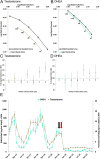The novel use of urinary androgens to optimise detection of the fertile window in giant pandas
- PMID: 35949393
- PMCID: PMC9354564
- DOI: 10.1530/RAF-22-0031
The novel use of urinary androgens to optimise detection of the fertile window in giant pandas
Abstract
Abstract: Giant pandas are mono-estrus seasonal breeders, with the breeding season typically occurring in the spring. Successful fertilization is followed by an embryonic diapause, of variable length, with birth in the late summer/autumn. There is a need for additional understanding of giant panda reproductive physiology, and the development of enhanced biomarkers for impending proestrus and peak fertility. We aimed to determine the utility of non-invasive androgen measurements in the detection of both proestrus and estrus. Urine from 20 cycles (-40 days to +10 days from peak estrus) from 5 female giant pandas was analyzed for estrogen, progestogens and androgens (via testosterone and DHEA assays), and hormone concentrations were corrected against urinary specific gravity. Across proestrus, estrogens increased while progestogens and androgens decreased - at the point of entry into proestrus, androgens (as detected by the testosterone assay) decreased prior to progestogens and gave 4 days advanced warning of proestrus. At the time of peak estrus, androgens (as detected by the DHEA assay) were significantly increased at the time of the decrease in estrogen metabolites from the peak, acting as an alternative confirmatory indicator of the fertile window. This novel finding allows for enlargement of the preparative window for captive breeding and facilitates panda management within breeding programmes. Androgens allow an enhanced monitoring of giant panda estrus, not only advancing the warning of impending proestrus, but also prospectively identifying peak fertility.
Lay summary: Giant pandas have one chance at pregnancy per year. The 2-day fertile window timing varies by year and panda. This is monitored by measuring the level of estrogens in the urine, which increase, indicating an upcoming fertile period. After 1-2 weeks of increase, estrogens peak and fall, marking the optimal fertile time. We tested other hormones to see if we can predict the fertile window in advance, and the specific fertile time with more accuracy. In 20 breeding seasons from 5 females, we found androgens, usually thought of as male hormones, had an important role. Testosterone gives 4 days advanced warning of estrogens increasing. DHEA identified peak estrogen and the fertile time before needing to see a confirmed decrease in estrogen itself. Therefore, androgens help improve monitoring of the giant panda breeding season, giving early warning of fertility, key in facilitating captive breeding and giant panda conservation.
Keywords: ELISA; breeding; estrus; female; hormones; non-invasive.
© The authors.
Figures


Similar articles
-
Changes in urinary androgen concentration indicate that male giant pandas (Ailuropoda melanoleuca) respond to impending female oestrus during and outside the typical spring breeding season.Reprod Fertil Dev. 2018 Jan;30(2):399-408. doi: 10.1071/RD16345. Reprod Fertil Dev. 2018. PMID: 28768568
-
Behavioral, semiochemical and androgen responses by male giant pandas to the olfactory sexual receptivity cues of females.Theriogenology. 2018 Jul 1;114:330-337. doi: 10.1016/j.theriogenology.2018.04.011. Epub 2018 Apr 11. Theriogenology. 2018. PMID: 29684811
-
Urinary estrogens as a non-invasive biomarker of viable pregnancy in the giant panda (Ailuropoda melanoleuca).Sci Rep. 2019 Sep 4;9(1):12772. doi: 10.1038/s41598-019-49288-6. Sci Rep. 2019. PMID: 31484972 Free PMC article.
-
Comprehensive Breeding Techniques for the Giant Panda.Adv Exp Med Biol. 2019;1200:275-308. doi: 10.1007/978-3-030-23633-5_10. Adv Exp Med Biol. 2019. PMID: 31471801 Review.
-
The influence of pharmaceutical compounds on male fertility.Andrologia. 1976;8(3):203-35. doi: 10.1111/j.1439-0272.1976.tb02137.x. Andrologia. 1976. PMID: 793446 Review.
References
-
- Belanger B, Balnger A, Labrie F, Dupont A, Cusan L, Monfette G.1989Comparison of residual C-19 steroids in plasma and prostatic tissue of human, rat and guinea pig after castration: unique importance of extratesticular androgens in men. Journal of Steroid Biochemistry 32695–698. (10.1016/0022-4731(8990514-1) - DOI - PubMed
MeSH terms
Substances
Grants and funding
LinkOut - more resources
Full Text Sources

